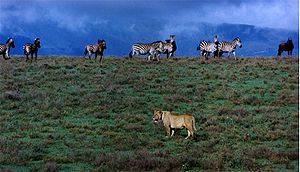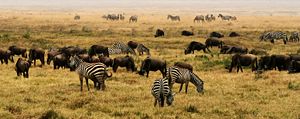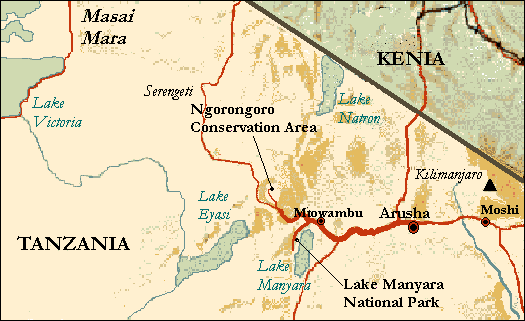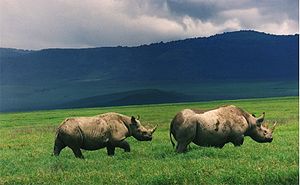
Ngorongoro Crater Tanzania

The Ngorongoro Conservation Area or NCA is a conservation area situated 180 km (112 miles) west of Arusha (See Map below). The conservation area is administered by the Tanzanian Government's Ngorongoro Conservation Area Authority. The Ngorongoro's boundaries follow the boundary of the Administrative Ngorongoro Division of Ngorongoro District. It covers an area of 8,288 km˛ (3,200 square miles).
 The Ngorongoro Crater is a world heritage site, the world’s largest intact volcanic caldera and is commonly referred to as the 8th wonder of the world. The 2,000 feet high walls of the approximately 10 mile wide crater create a natural amphitheatre for the densest populations of large animals anywhere. It is a microcosm of the vast Serengeti National Park and in one day it is possible to see a staggering array of East African wildlife including all the big carnivores.
The Ngorongoro Crater is a world heritage site, the world’s largest intact volcanic caldera and is commonly referred to as the 8th wonder of the world. The 2,000 feet high walls of the approximately 10 mile wide crater create a natural amphitheatre for the densest populations of large animals anywhere. It is a microcosm of the vast Serengeti National Park and in one day it is possible to see a staggering array of East African wildlife including all the big carnivores.
The crater lives up to its infamous reputation with abundant and easily accessible wildlife and offers a reasonable chance to see lion, hyena or cheetah in action. The Crater is truly awe-inspiring and will surely be one of the highlights of your safari. The rim of the Ngorongoro Crater ranges in altitude from about 7,000 feet to 8,000 feet. Down below, the relatively flat floor of the Crater rests at an elevation of about 5,500 feet.
 The Ngorongoro Crater's rich soils and abundant, year-round water provide an ideal habitat for a variety of animals. The Crater is not a self-contained ecosystem and some animals do migrate in and out but only in small numbers. Most of the animals in the Crater are resident and remain year-round. There are approximately 20,000 large mammals at any given time within the Crater walls.
The Ngorongoro Crater's rich soils and abundant, year-round water provide an ideal habitat for a variety of animals. The Crater is not a self-contained ecosystem and some animals do migrate in and out but only in small numbers. Most of the animals in the Crater are resident and remain year-round. There are approximately 20,000 large mammals at any given time within the Crater walls.
Herbivores that you will likely encounter include elephant, black rhino, hippo, buffalo, eland, zebra, wildebeest, hartebeest, waterbuck, warthog, Grant’s gazelle and Thomson’s gazelle. Giraffe, impala and topi are strangely absent from the Crater floor, though they are common in the nearby Serengeti. Although giraffes may find the descent into the Crater difficult, it is more likely that they are absent because there is not enough acacia to browse. It is not clear why topi or impala are missing. Primates include baboons and vervet monkeys. Carnivores that you will likely encounter include lion, cheetah, hyena and jackal. Leopards, servals, bat eared foxes and ratels are also resident within the Crater but are much more elusive.

Map Showing the Ngorongoro Conservation area
History and geography
 Based on fossil evidence found at the Olduvai Gorge, it is known that various
hominid species have lived in the area for about 3 million years. Hunters &
gatherers were replaced by pastorialists a few thousand years ago. The Mbulu
people came to the area about 2,000 years ago, and were only joined by the
Datoga around the year 1700. Both groups were driven away from the area by the
Maasai in the 1800s. Massive fig trees in the northwest of the Lerai Forest are
sacred to the Maasai and Datoga people. Some of them may have been planted on
the grave of a Datago leader who died in battle with the Maasai around 1840.
Based on fossil evidence found at the Olduvai Gorge, it is known that various
hominid species have lived in the area for about 3 million years. Hunters &
gatherers were replaced by pastorialists a few thousand years ago. The Mbulu
people came to the area about 2,000 years ago, and were only joined by the
Datoga around the year 1700. Both groups were driven away from the area by the
Maasai in the 1800s. Massive fig trees in the northwest of the Lerai Forest are
sacred to the Maasai and Datoga people. Some of them may have been planted on
the grave of a Datago leader who died in battle with the Maasai around 1840.
No Europeans are known to have set foot in the Crater until 1892, when it was visited by Dr. Oscar Baumann. Two German brothers farmed in the Crater until the outbreak of World War I, after leasing the land from the German colonial administration then in control of East Africa. Dr. Baumann shot three rhinos while camped in the crater, and the German brothers regularly organized shooting parties to entertain their German friends. They also attempted to drive the wildebeest herds out of the crater.
The Ngorongoro area originally was part of the Serengeti National Park when it was created by the British in 1951. Maasai continued to live in the newly created park until 1959, when repeated conflicts with park authorities over land use led the British to evict them to the newly declared Ngorongoro Conservation Area.
The Ngorongoro Conservation Area Authority is the governing body regulating use and access to the NCA. The area became a UNESCO World Heritage Site in 1979.
Land in the conservation area is multi-use, it is unique in Tanzania as the only conservation area providing protection status for wildlife whilst allowing human habitation. As such land use is controlled to prevent negative effects on the wildlife population, for example cultivation is prohibited at all but subsistence levels.
The area is part of the Serengeti ecosystem, and to the north-west, it adjoins the Serengeti National Park and is contiguous with the southern Serengeti plains, these plains also extend to the north into unprotected Loliondo division and are kept open to wildlife through trans-human pastoralism practiced by Maasai. The south and west of the area are volcanic highlands, including the famous Ngorongoro Crater and the lesser known Empakai. The southern and eastern boundaries are approximately defined by the rim of the Great Rift Valley wall, which also prevents animal migration in these directions.
The annual ungulate migration passes through the NCA, with wildebeest and zebra moving south into the area in December and moving north in June. This movement changes seasonally with the rains, but the migration will traverse almost the entire plains in search of food. The NCA has a healthy resident population of most species of wildlife, in particular the Ndutu Lake area to the west has strong cheetah and lion populations